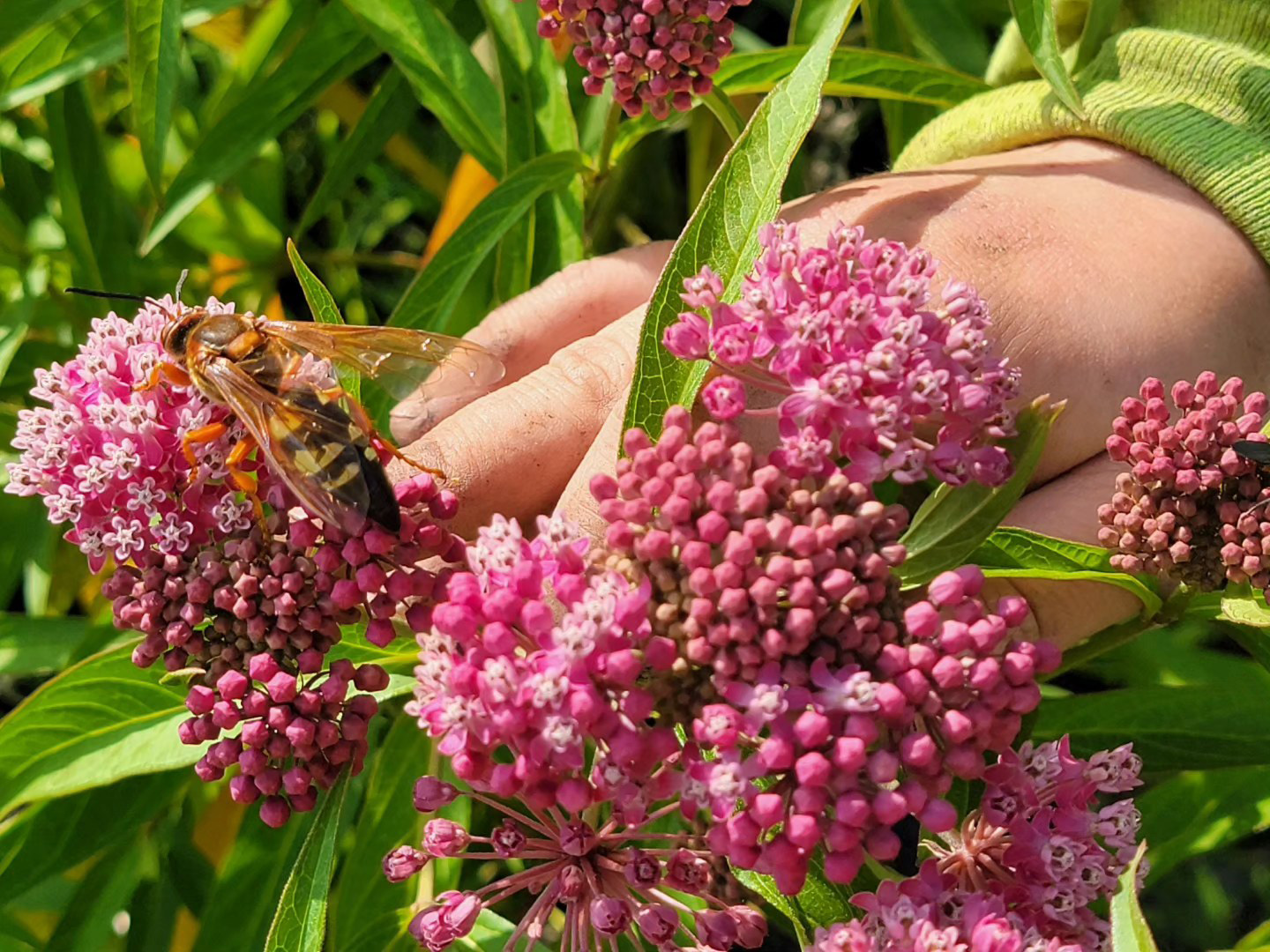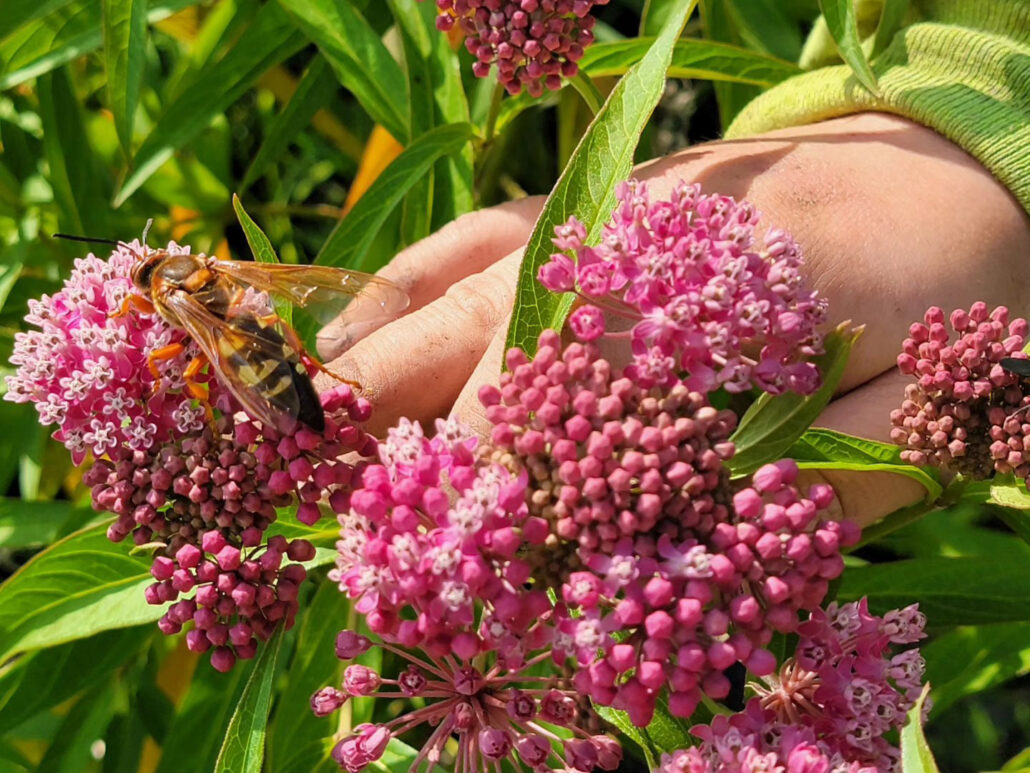
by Kate Redmond
The Clover Leaf Weevil and Other Tales
Howdy, BugFans,
A while back, BugFan Laurel shared this picture of a wasp that was photographed by her friend, Joel, who gave the BugLady permission to use it. Thanks, Joel.
This is one large wasp. In an article about it on the New Jersey Agricultural Experiment Station website, William Sciarappa writes “Few insects can compare with the alarm caused by Cicada Killer Wasps.” At lengths up to 2” (females are larger than males – more about that later), it’s one of the largest in the country, so let’s get this out of the way up front. No, the male can’t sting, though he does have a “pseudo-stinger,” and he sometimes “pseudo-stings” with it. Yes, she can sting https://bugguide.net/node/view/807314/bgimage, but she’s a solitary rather than a social wasp, with no motivation to defend hearth and home, so you have to mistreat or step on her in order to get stung (or be a cicada). Though there were a couple of dissenting voices, most sources agree that her bark is worse than her bite – on the Schmidt Insect Sting Pain Index, which rates pain on a scale of one to four, the Cicada killer’s sting is 0.5, lower than that of a honey bee. One article called her “a marshmallow.”
Eastern Cicada-killer wasps (Sphecius speciosus) (speciosus means “showy” or “beautiful”) are in the Square-headed/Sand wasp family Crabronidae. Four species in the genus (the Pacific, the Western, the Eastern, and the Caribbean Cicada-killers) combine to cover much of the Lower 48, south into Central America (there’s a South American Cicada-killer, and there are more species in the Old World). They’re also called Giant cicada-killers, Cicada hawks, and Giant ground-hornets. When the Northern giant hornet (formerly known as the Asian giant hornet/Murder hornet) arrived in the far Northwestern portions of the country, panicky folks in the East were mistaking cicada-killers for murder hornets.

They prefer sunny edges, gardens, banks, berms, and disturbed spots with loose clay to well-drained sandy soil, close to trees that may harbor cicadas. There are pictures of them using cracks in sidewalks and patio bricks, window boxes and planters as nest sites. Here’s a nice collection of pictures of Eastern Cicada-killers at work and at play https://www.marylandbiodiversity.com/view/6434.
Adults feed on tree sap and on nectar from flowers (and, apparently, peaches https://bugguide.net/node/view/820925/bgimage), and they’re considered pollinators. Cicadas are the only food enjoyed by their larvae. William Sciarappa again, “The female wasp strikes and stuns the Cicada which reacts with a loud shrieking buzz. Both of these very large insects tumble to the ground where the stinger is then utilized to paralyze the Cicada. This relatively huge prey is laboriously dragged up a tree or tall plant. The Cicada is often held upside down and straddled, after which the wasp takes off and glides home to the nest.” If there’s no place for her to gain altitude, she will walk the cicada back to her nest tunnel. The Western CKW has a preference for male cicadas and the Eastern and Caribbean CKWs for females. She apparently locates her prey by sight rather than sound (female cicadas are silent).
A Cassin’s Flycatcher was observed flying out and intercepting prey-laden incoming female wasps and relieving them of their cicadas. Skunks may dig up the larvae, and the odd spider may snag an adult. A “velvet ant” (which is actually a kind of flightless female wasp) https://bugguide.net/node/view/2023193/bgimage, sneaks into her tunnel and lays an egg in an egg chamber (the ECKW leaves the chambers open until they’re fully provisioned), and the velvet ant larva parasitizes the ECKW pupa.
So – were ECKWs in hog heaven during the historic outbreak of Periodical cicadas this summer (https://uwm.edu/field-station/bug-of-the-week/the-cicadas-are-coming-a-tale-in-four-parts/)? They were not – because of their phenology, they missed the show. ECKWs target several genera of Dog-day cicadas that emerge after the Periodical cicadas are done. The supply of Periodical cicadas is boom or bust, but the supply of Dog day cicadas is more dependable, so ECKWs are tuned into their cycles.
Male ECKWs emerge when the cicadas start calling, and females emerge about a week later. Males are very territorial, defending their turf against just about anything that enters it, deliberately crashing into intruding insects, while constantly trying to attract females. They inspect and follow people fearlessly but will fly off if swatted at. They communicate by buzzing their wings, warning away other males (the largest males make the loudest buzz), and buzzing may also be part of courtship. They gather in groups (mating aggregations or leks), scouting areas where females might be and duking it out in mid-air. Females call to males using pheromones.
They mate on the ground https://bugguide.net/node/view/374679/bgimage https://bugguide.net/node/view/206285/bgimage and then take to the air. The female “leads, but his wing beats help power the flight, even though they’re facing opposite directions.
Females dig burrows that are 10” to 20” deep and 30” to 70” long with as many as a dozen egg chambers. She leaves a U-shaped trench of soil near the entrance, to the dismay of lawn-owners and golf course maintenance crews (the best defense is a well-watered, dense, healthy turfgrass). She loosens the dirt with her jaws and kicks it out with her hind legs, eventually displacing, said one source, several pounds of soil or, said another source, 100 cubic inches of dirt. Even though they’re not social, several females may share a burrow, each excavating her own set of egg chambers. She provisions each with a cicada or three, lays an egg on a cicada leg, seals the cell, and departs https://bugguide.net/node/view/2391638/bgimage, and she may handle 30 or more cicadas in her lifetime. The eggs hatch, and the larva eats its cicada in a specific order that keeps the cicada alive until the larva is ready to pupate https://bugguide.net/node/view/1328710/bgimage.
They overwinter as mature larvae in a cocoon, pupate, and dig out of the tunnel as adults in late spring. Their flight period is about two months; males die after mating, and females die after egg-laying.
Female ECKWs have a superpower, but the BugLady found two different explanations of it. They have, as they lay their eggs, the ability to determine whether the egg will be male or female, or possibly, an awareness of the egg’s gender. Males may mate several times, but females only mate once, so she stores his bodily fluid in a receptacle called a spermatheca, meting it out as needed as she gradually fills tunnels and egg chambers. According to one version, if she does not fertilize the egg, the larva will be a male, and if she does, the larva will be female. According to the second version, the female somehow senses whether the egg she’s about to lay is male or female. In either case, males are allotted a single cicada, but the eventual females are provisioned with two or three. Females end up twice as large as males, but they have the job of toting around cicadas that are larger and bulkier than they are. And – Mother Wasp also ensures that there are more females than males in the population.
Ain’t Nature Grand!
On a different note: After reading the story of the spider that went to the laundromat in last week’s BOITW, two BugFans shared their own experiences with car spiders. One keeps the outside of her car a little dirty, so the spiders have something to grip; the other BugFan (not-so-much of a spider fan) was unnerved by a large jumping spider that was inside the car as she drove, alternately staring at her (jumping spiders are good at that) and then disappearing as she drove (that, too).
Kate Redmond, The BugLady
Bug of the Week archives:
http://uwm.edu/field-station/category/bug-of-the-week/
